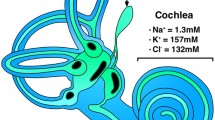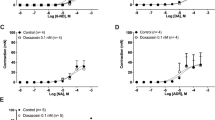Summary
The effects of adrenergic nerve stimulation and catecholamines administered in vitro and in vivo on passive water and active and passive salt movement across epithelia have been reviewed. In general, where catecholamines affect these movements decreases are mediated by α- and increases by β-adrenoceptors. However, some species and considerable tissue differences in the responses which can be ellicited are evident. Thus:
-
1.
α-Adrenoceptor activation antagonises drugs which increase water movement across amphibian skin and bladder without, in the latter, modifying the resting permeability.
-
2.
In amphibian skins and in fish gills β-adrenoceptors mediate the increase in resting water flux caused by low concentrations of catecholamines.
-
3.
β-Adrenoceptors mediate an increase in permeability with salt efflux and a stimulation of mucus secretion in amphibian skin.
-
4.
α-Adrenoceptors mediate a reduction in Na+ movement across amphibian skin and fish gill respiratory epithelium; however adrenaline has little action on Na+ permeability of amphibian bladder.
-
5.
β2-Adrenoceptors mediate the increased Na+ permeability caused by low concentrations of catecholamines.
The localisation of the mechanisms responsible for these actions and their possible physiological significance is discussed.
Similar content being viewed by others
References
Ambalavanar, S.: Actions and interactions of drugs affecting transport processes in frog skin and toad bladder. M. Sc. Thesis, Manchester 1971.
Ambalavanar, S., Foster, R. W., Schnieden, H.: Effects of sympathomimetics on water movement across toad isolated bladder. J. Pharm. Pharmacol. 24, 501–502 (1972)
Ambalavanar, S., Foster, R. W., Schnieden, H.: The adrenoceptors mediating catecholamine effects in frog isolated skin. J. Pharm. Pharmacol. 25, 55–59 (1973)
Andersen, B., Ussing, H. H.: Solvent drag on non-electrolytes during osmotic flow through isolated toad skin and its response to antidiuretic hormone. Acta physiol. scand. 39, 228–239 (1957)
Bastide, F., Jard, S.: Actions de la noradrénaline et de l'ocytocine sur le transport actif de sodium et la perméabilité à l'eau de la peau de grenouille. Rôle du 3′,5′-AMP cyclique. Biochim. biophys. Acta (Amst.) 150, 113–123 (1968)
Falck, B., Häggendal, J., Owman, C.: The localisation of adrenaline in adrenergic nerves in the frog. Quart. J. Physiol. 48, 253–257 (1963)
Fassina, G., Carpenedo, F., Fiandine, G.: The effects of catecholamines and β-antiadrenergic drugs on isolated short-circuited skin of the frog. J. Pharm. Pharmacol. 20, 240–242 (1968)
Friedman, R. T., La Prade, N. S., Aiyawar, R. M., Huf, E. G.: Chemical basis for the [H+] gradient across frog skin. Amer. J. Physiol. 212, 962–972 (1967)
Gonzales, C., Sanchez, J., Concha, J.: Changes in potential difference and shortcircuit current produced by electrical stimulation in a nerve-skin preparation of the toad. Biochim. biophys. Acta (Amst.) 120, 186–188 (1966)
Gonzales, C., Sanchez, J., Concha, J.: Further evidence for the release of noradrenalin under nerve stimulation and its effects on the potential difference in toad nerve-skin preparations. Biochim. biophys. Acta (Amst.) 135, 167–170 (1967)
Handler, J. S., Bensinger, R., Orloff, J.: Effects of adrenergic agents on toad bladder response to ADH, 3′,5′-AMP and theophylline. Amer. J. Physiol. 215, 1024–1031 (1968)
House, C. R.: The role of glandular activity in the electrical response of amphibian skin to noradrenaline. J. Physiol. (Lond.) 202, 631–644 (1969)
House, C. R.: The effect of noradrenaline on the toad skin potential. J. Physiol. (Lond.) 209, 513–539 (1970)
Jard, S., Bastide, F., Morel, F.: Analyse de la relation “dose-effect biologique” pour l'action de l'ocytocine et de la noradrénaline sur le peau et la vessie de la grenouille. Biochim. biophys. Acta (Amst.) 150, 124–130 (1968)
Kirschner, L. B.: Ventral aortic pressure and sodium fluxes in perfused eel gills. Amer. J. Physiol. 217, 596–604 (1969)
Koefoed-Johnsen, V., Levi, H., Ussing, H. H.: The mode of passage of chloride ions through the isolated frog skin. Acta physiol. scand. 25, 150–163 (1952)
Koefoed-Johnsen, V., Ussing, H. H.: The contributions of diffusion and flow to the passage of D2O through living membranes. Acta physiol. scand. 28, 60–76 (1953)
Koefoed-Johnsen, V., Ussing, H. H., Zerahn, K.: The origin of the short-circuit current in the adrenaline stimulated frog skin. Acta physiol. scand. 27, 38–48 (1953)
Leaf, A., Anderson, J., Page, L. B.: Active sodium transport by the isolated toad bladder. J. gen. Physiol. 41, 657–668 (1958)
Leaf, A., Hays, R. M.: Permeability of the isolated toad bladder to solutes and its modification by vasopressin. J. gen. Physiol. 45, 921–932 (1962)
Lindley, B. D.: Nerve stimulation and electrical properties of frog skin. J. gen. Physiol. 53, 427–449 (1969)
Marcelin-Plaisance, J., Concha-Barahona, J.: Action comparée de l'adrénaline et de la noradrénaline sur la différence de potentiel et le courant de court-circuit au niveau de la peau de Crepaud isolée. J. Physiol. (Paris) 55, 425–432 (1963)
Martin, D. W., Curran, P. F.: Reversed potentials in isolated frog skin. II. Active transport of chloride. J. Cell Physiol. 67, 367–372 (1966)
McAfee, R. D.: The action of beta adrenergic site stimulating catecholamines on isolated frog skin. Biochim. biophys. Acta (Amst.) 203, 104–110 (1970)
Pic, P., Mayer-Gostan, N., Maetz, J.: Sea-water teleosts: presence of α and β adrenergic receptors in the gill regulating salt extrusion and water permeability. Proc. 1st Int. Congr. on Comparative Physiology, Acquasparta (Italy), Sept. 1972. Amsterdam-London: North Holland Publ. Co. 1972
Rajerison, R. M., Montegut, M., Jard, S., Morel, F.: The isolated frog skin epithelium: presence of α and β adrenergic receptors regulating active sodium transport and water permeability. Pflügers Arch. 332, 313–331 (1972)
Randall, D. J., Baumgarten, D., Malyusz, M.: The relationship between gas and ion transfer across the gills of fishes. Comp. Biochem. Physiol. 41A, 629–637 (1972)
Richards, B. D., Fromm, P. O.: Sodium uptake by isolated-perfused gills of rainbow trout (Salmo gairdneri). Comp. Biochem. Physiol. 33, 303–310 (1970)
Van Rossum, J. M.: Different types of sympathomimetic α-receptors. J. Pharm. Pharmacol. 17, 202–216 (1965)
Schoffeniels, E., Salee, M.-L.: The effects of the electrical stimulation of the brachial plexus on the potential difference of frog skin. Comp. Biochem. Physiol. 14, 587–602 (1965)
Seldin, J. P., Hoshiko, T.: Ionic requirements for epinephrine stimulation of frog skin gland secretion. J. exp. Zool. 163, 111–114 (1966)
Ussing, H. H.: The active ion transport through the isolated frog skin in the light of tracer studies. Acta physiol. scand. 17, 1–37 (1949)
Ussing, H. H., Zerahn, K.: Active transport of sodium as the source of electric current in the short-circuited isolated frog skin. Acta physiol. scand. 23, 110–127 (1951)
Watlington, C. O.: The nature of adrenergic influence on sodium transport in frog skin. J. clin. Invest. 44, 1108 (1965)
Watlington, C. O.: Alpha and beta adrenergic stimulation and sodium transport across frog skin. Clin. Res. 15, 52 (1967)
Watlington, C. O.: Effects of catecholamines and adrenergic blockade on sodium transport of isolated frog skin. Amer. J. Physiol. 214, 1001–1007 (1968a)
Watlington, C. O.: Effect of adrenergic stimulation on ion transport across skin of living frogs. Comp. Biochem. Physiol. 24, 965–974 (1968b)
Watlington, C. O.: α-Adrenergic inhibition of Na+ transport: the interaction of vasopressin and 3′,5′-AMP. Biochim. biophys. Acta (Amst.) 193, 394–402 (1969)
Watlington, C. O., Burke, P. K., Campbell, A. D. Huf, E. G.: Systemic effects of epinephrine in the frog. J. cell comp. Physiol. 65, 337–354 (1965)
Watlington, C. O., Campbell, A. D., Huf, E. G.: Ion transport in skin of live frogs. J. cell. comp. Physiol. 64, 389–408 (1964)
Watlington, C. O., Spath, J. A., Berry, E. R., Huf, E. G.: Secretory responses of frog skin to chemical stimulation. Fed. Proc. 27, 233 (1968)
Author information
Authors and Affiliations
Rights and permissions
About this article
Cite this article
Foster, R.W. Adrenoceptors and salt and water movement in epithelia. Naunyn-Schmiedeberg's Arch. Pharmacol. 281, 315–326 (1974). https://doi.org/10.1007/BF00500600
Received:
Issue Date:
DOI: https://doi.org/10.1007/BF00500600




